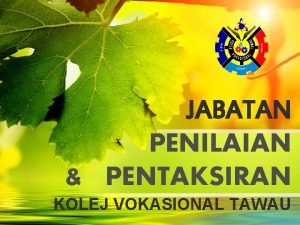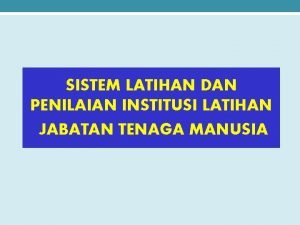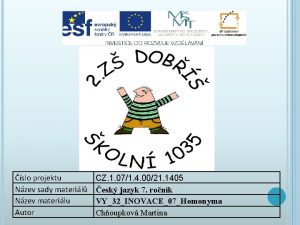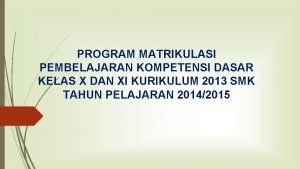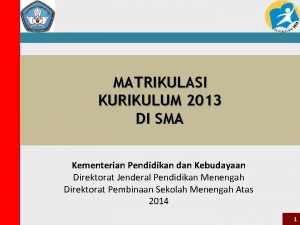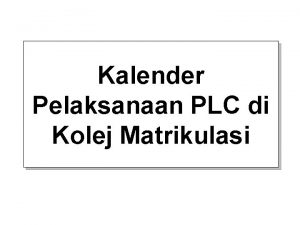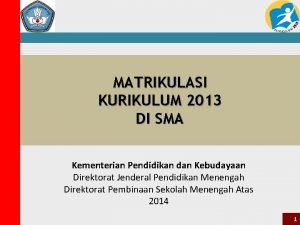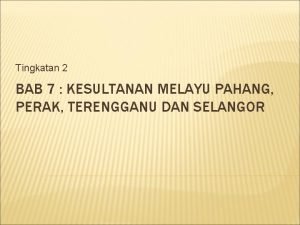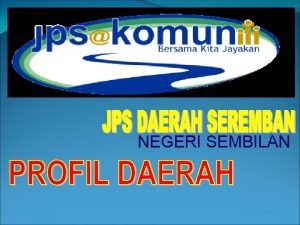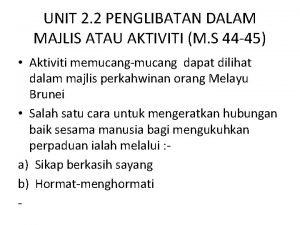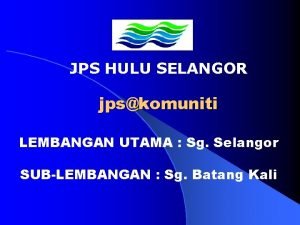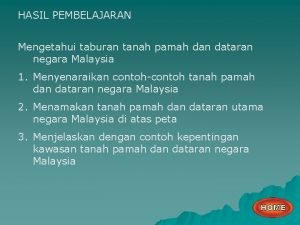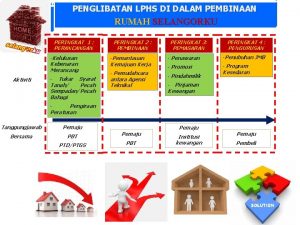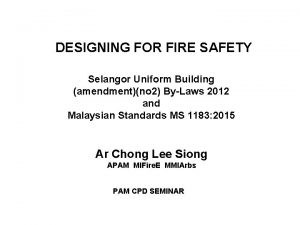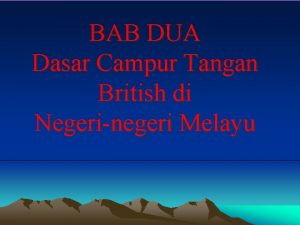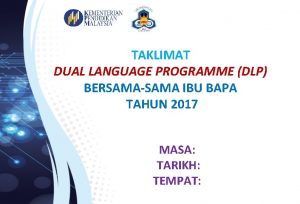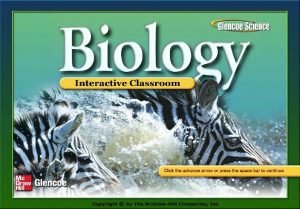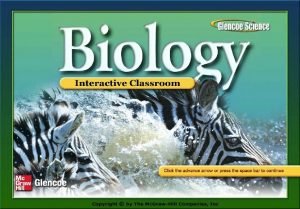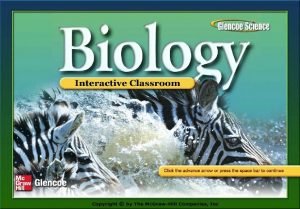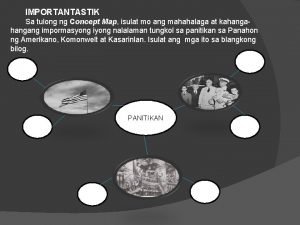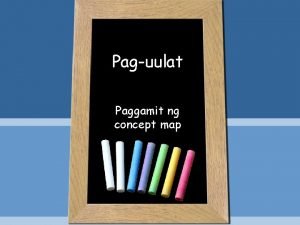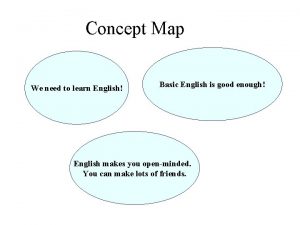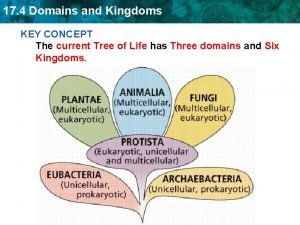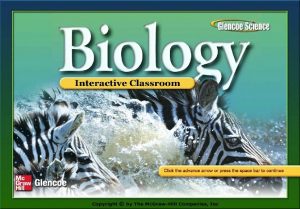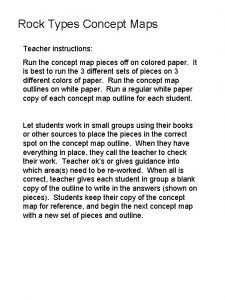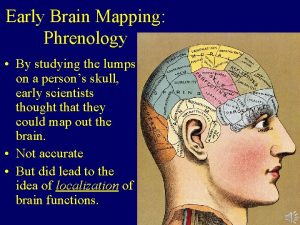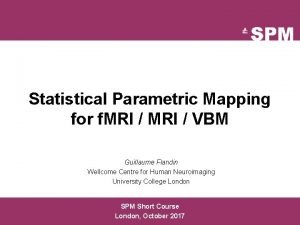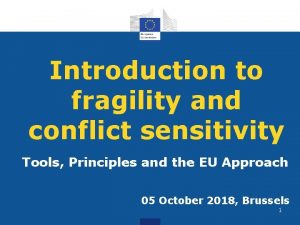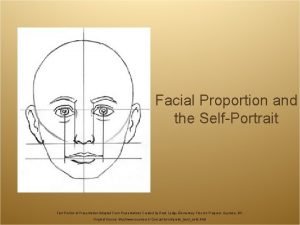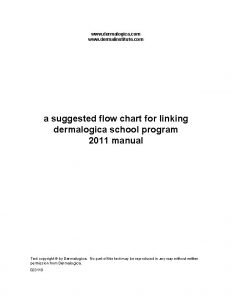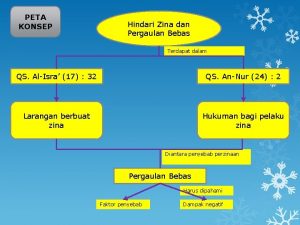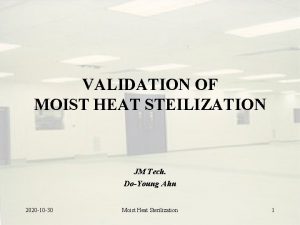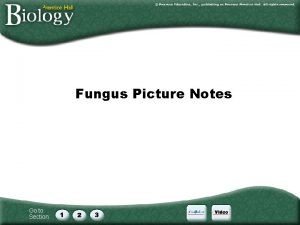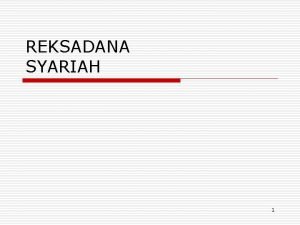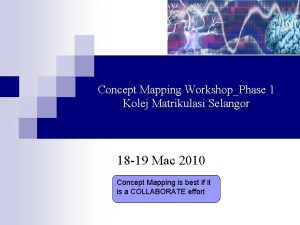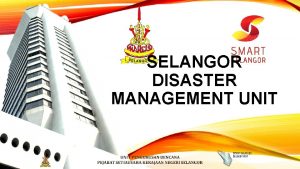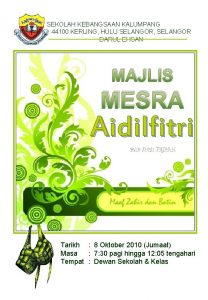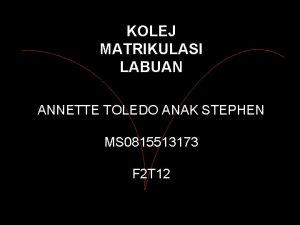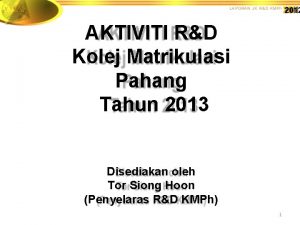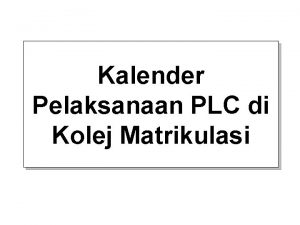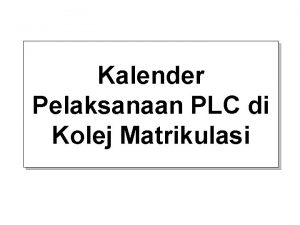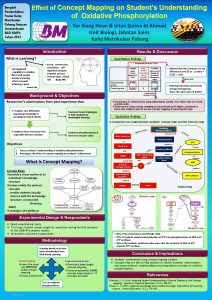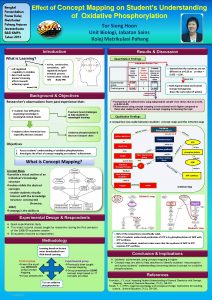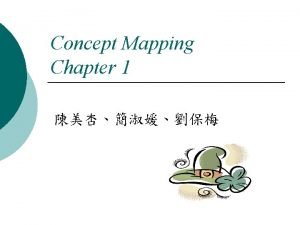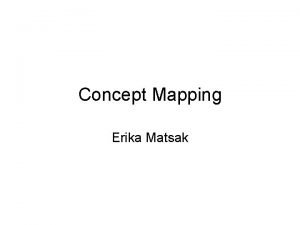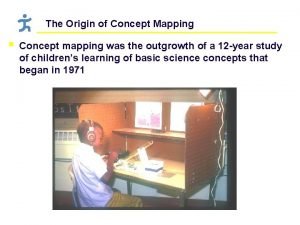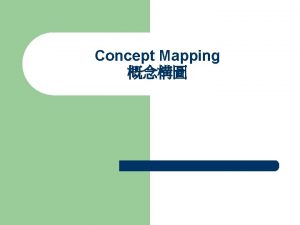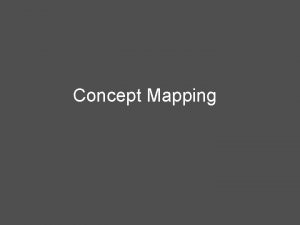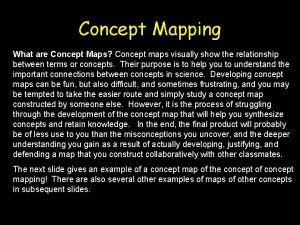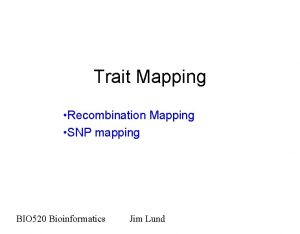Concept Mapping WorkshopPhase 1 Kolej Matrikulasi Selangor 18























































- Slides: 55

Concept Mapping Workshop_Phase 1 Kolej Matrikulasi Selangor 18 -19 Mac 2010 Concept Mapping is best if it is a COLLABORATE effort

Workshop shedule Slot 1 Introduction to Concept Mapping Slot 2 Uses of Concept Map in Teaching and Learning Slot 3 Creating Concept Maps Slot 4 Presentation of Concept Maps (Paper and Pencil) Slot 5 Presentation of Concept Maps (Concept Mapping Software) Conclusion and Reflections

Scope in Concept Map Workshop Refer Pg 2

Our scope during this workshop: Concept Mapping Workshop_Phase 1

From: http: //cmap. ihmc. us/ KMS_Concept Mapping Workshop

Slot 1 Introduction to Concept Mapping KMS_Concept Mapping Workshop

Menu for Slot 1 1. 2. 3. 4. 5. 6. What is a Concept Map? Theory underlying Concept Mapping Basics about Concept Mapping Assessing Concept Map Creating a Concept Map Electronic Tools Available to Support Concept Mapping 06 -Mar-21 KMS_Concept Mapping Workshop 7

1. What is a Concept Map? Refer Pg 3

Concept Maps n n n Graphic organizer that displays a large concept or theme from a big -picture perspective Uses concepts or ideas and shows how they connect: using language Networks consist of nodes and links. Nodes represent concepts and links represent the relations between concepts. Linking words are used to describe the relationships among the concepts 06 -Mar-21 KMS_Concept Mapping Workshop 9

Concept Maps n n Educational tool that encourages meaningful learning. An active, creative, visual and spatial learning activity in which concepts are organized according to their hierarchical relationships. 06 -Mar-21 KMS_Concept Mapping Workshop 10

What is concept mapping? n n A technique for organizing and representing information A true concept map must include: ¨ core concepts - usually enclosed in circles or boxes ¨ relationships illustrated by lines and arrows connecting concepts AND by propositions or statements on those lines that explain the nature of the relationship Books Pages are made of Binding

2. Theory underlying Concept Mapping Refer Pg 3

Novak’s Concept Mapping Technique Developed by Joseph D. Novak at Cornell University. • concluded that "Meaningful learning involves the assimilation of new concepts and propositions into existing cognitive structures". Novak’s work was based on theories of Ausubel. 06 -Mar-21 KMS_Concept Mapping Workshop 13

New Theory of Learning Novak and Gowan (1984) • developed a theory of instruction that is based on Ausubel's meaningful learning principles • incorporates "concept maps" to represent meaningful relationships between concepts and propositions. 06 -Mar-21 KMS_Concept Mapping Workshop 14

Ausubel Meaningful Learning n Learning with understanding ¨ much stronger and longer- lasting than rote learning by memorization ¨ students address the conceptual meaning of the knowledge being learned, and link this new information with previous knowledge 06 -Mar-21 KMS_Concept Mapping Workshop 15

Meaningful Learning VS Rote Learning 06 -Mar-21 KMS_Concept Mapping Workshop 16

How can you encourage Meaningful Learning? n n n Organize knowledge ¨ ideas (Schemata) are inter-connected as networks according to the meaning that defines them. Guide students ¨ to anchor new ideas or concepts with previous defined knowledge in a non-arbitrary way Introduce Concept Mapping to promote meaningful learning 06 -Mar-21 KMS_Concept Mapping Workshop 17

Key idea of New Theory of Learning Jane Primary 6 Each learner comes into any new situation with prior knowledge based on past experiences. 06 -Mar-21 18

Key idea of New Theory of Learning Jane Form FOUR New knowledge is learned through integration with prior knowledge. 06 -Mar-21 19

3. Basics about Concept Maps Refer Pg 5 KMS_Concept Mapping Workshop

n n n Two concepts linked by a labelled relationship create a proposition This ‘scaffolds’ the formation of a meaningful statement. It is the basic unit in the formation of concept maps. A cat is a living thing. n This makes concept mapping a powerful tool in learning how to structure ideas and make connections to frame meanings. 06 -Mar-21 KMS_Concept Mapping Workshop 21

Basic structures of graphic representation Level of concept mapping Concept mapping: n n n represents different levels of meaning discloses levels of understanding or misrepresentation allows cloze style presentations 06 -Mar-21 Concept mapping representation Interplay between the visual and linguistic elements. could mean; The cat ate the mat. The cat went to the mat. The cat walked over the mat. The mat belongs to the cat. The mat is near the cat. The number of possible interactions and types of different relations between the cat and mat are many and diverse. could mean; The cat went to the mat. The cat saw the mat. The cat likes the mat. The directionality given by the vector is explicit although the definition of the relationship is unclear. It gives a structure to the possible linguistic interpretations in terms of subject/object order. could mean; The cat ate on the mat. The cat ran on the mat. The cat sleeps on the mat. The mat is on the cat. Although the relationship has been given more clarity in terms of relation by naming the link, the interaction is still lacking clarity in terms of the order of relationship. could mean; The cat went on the mat. The cat is on the mat. The combination of vector and naming of the link reduces the number of possibilities in interpretation. The relationship achieves more definition and the whole representation becomes more meaningful. could only mean; The cat is on the mat. The inclusion of a more constrained label to the vector achieves an accurate and meaningful proposition in terms of objects and their relations. KMS_Concept Mapping Workshop 22

Some basics about Concept Map A Concept Map Includes: laptop Linking Phrase Nodes (terms or concepts) needs a Linking lines (usually with a unidirectional arrow) Linking phrases Linking Phrase charge Linking Phrase Propositions 06 -Mar-21 KMS_Concept Mapping Workshop 23

Some basics about Concept Map Propositions “The basic unit of meaning in a concept map and the smallest unit that can be used to judge the validity of the relation (line) drawn between two concepts” Linking Phrase Ruiz-Primo and Shavelson, 1996 Linking Phrase Propositions 06 -Mar-21 KMS_Concept Mapping Workshop 24

Some basics about Concept Map What are Propositions? n n n concept maps constructed of propositions (two concepts connected by a short linking phrase) which are the unit of meaning (perhaps analogous to sentence) the brief linking phrase describes the relationship between the two concepts anyone can draw lines between words, but connecting these with a phrase creates the window into understanding 06 -Mar-21 25

4. Assessing a Concept Map Refer Pg 5

Assessing Concept Maps n n n Assessing and evaluating concept Maps Summative assessments ¨ Formal assessments designed to determine what students do and do not know Formative assessments ¨ Informal assessments designed to check on students’ progress 06 -Mar-21 27

Items Commonly Assessed n n were the correct concepts or nodes identified? do the lines and arrows correctly link concepts together into clusters or hierarchies? do the propositions or statements on the lines between concepts accurately describe how two concepts are related? how detailed are the resources or elaborative examples attached to the concepts (e. g. , Web links, articles, annotations, notes, excerpts cut and pasted from a class discussion board, etc. ) 06 -Mar-21 28

Scoring Methods (Mc. Clure, Sonak & Suen, 1999) n n were the correct concepts or nodes identified? do the lines and arrows correctly link concepts together into clusters or hierarchies? do the propositions or statements on the lines between concepts accurately describe how two concepts are related? how detailed are the resources or elaborative examples attached to the concepts (e. g. , Web links, articles, annotations, notes, excerpts cut and pasted from a class discussion board, etc. ) 06 -Mar-21 29

Some basics about Concept Map Basis of Concept Maps General Level 1 Level 2 Level 3 Specific 06 -Mar-21 KMS_Concept Mapping Workshop 30

Structural Scoring Novak Scoring Protocol 06 -Mar-21 hierarchical structure, concept-links, cross-links, and examples 31

Relational Scoring n n Quality or importance of each individual conceptlink, without regard to the overall structure of the map, e. g. one point for each correct link and proposition. Modified relational scoring where, concept-links, cross-links, and examples were assessed using the following scale (West, et al) : invalid relationship between concepts (0 points); valid relationship between concepts but propositional label is incorrect (1 point); ¨ valid relationship and propositional label correct but lacks foundational or core relationship to subject matter (2 points); and ¨ valid relationship and propositional label and foundational or core relationship apparent (3 points). ¨ ¨ 06 -Mar-21 KMS_Concept Mapping Workshop 32

Scoring A Concept map Relational Scoring 06 -Mar-21 Structural Scoring KMS_Concept Mapping Workshop 33

Scoring A Concept map 1. STRUCTURAL SCORING Propositions (if valid) Hierarchies (if valid) Cross-links (if valid) Examples (if valid) Total Score = 1 X ? = Score = 5 X ? = Score = 10 X ? = Score = 1 X ? = 2. RELATIONAL SCORING Is there any relationship between the concepts of the proposition? Does the label indicate a possible relationship between the concepts of the proposition? YES 0 1 NO NO Does the direction of the arrow indicate an hierarchical, causal, or sequential relationship between the concepts of the proposition that is compatible with the label? YES 2 NO 3 ? ? ?

Holistic Scoring Rubrics (1) link 1 06 -Mar-21 35

Scoring Rubrics (2) Cooperation Content Organization Exemplary 4 Well organized Logical format Contains main concepts Contains a appropriate number of concepts Map is “treelike” and not stringy Follows standard map conventions Linking words demonstrate superior conceptual understanding Links are precisely labeled Worked extremely well with each Respected and complemented each others ideas Exceeds Standard 3 Adequately Meets Standard 2 Below Standard 1 Thoughtfully organized Easy to follow most of the time Contains most of the main concepts Contains an adequate number of concepts Follows the standard map conventions Linking words easy to follow but at times ideas unclear Links are not precisely labeled Somewhat organized Somewhat incoherent Contains only a few of the main concepts Choppy and confusing Contains a limited number of concepts Worked very well with each other. Worked to get everyone involved Attempted to work Little or no well with others. teamwork At times ”off task” and not everyone was actively involved Linking words are Difficult to clear but present a follow flawed rationale No links Links are not labeled Student Score _______ link 2 Refer Exercise Pg 7

5. Creating a Concept Map Refer Pg 8

Stages in Creating A Concept Map 1. 2. 3. 4. 5. 6. 06 -Mar-21 Brainstorming Stage Organizing Stage Layout Stage Linking Stage Revising Stage Finalizing Stage KMS_Concept Mapping Workshop 38

Stages in Creating A Concept Map 1. Brainstorming Stage Find a focus question. n Make a list of terms, a single word or a phrase by going through your notes. n Make a list of these items and print them neatly. n Your objective here is to generate the largest possible list you can. n 06 -Mar-21 KMS_Concept Mapping Workshop 39

Stages in Creating A Concept Map 2. Organizing Stage n n n Spread concepts on a table or whiteboard so that all can be read easily Create groups and sub-groups of related items. Try to group items to emphasize hierachies. Identify terms that represent higher categories and add them. Feel free to rearrange items and introduce new items omitted initially. Some concepts will fall into multiple groupings. This will become important in the linking stage. 06 -Mar-21 KMS_Concept Mapping Workshop 40

Stages in Creating A Concept Map 3. Layout Stage Arrange terms so that they represent your collective understanding of the interrelationships and connections among grouping. n Use a consistent hierarchy in which the most important concepts are in the center or at the top. n Within subrouping, place closely the items in a simple sentence that shows the relationship between them. n Feel free to rearrange things at any time during this phase. n Do not expect your layout to be like that of other 41 KMS_Concept Mapping Workshop 06 -Mar-21 groups. n

Stages in Creating A Concept Map 4. Revising Stage n Carefully examine the draft concept map. n Rearrange sections to emphasize organization and appearance n Remove or combine items to simplify. n Consider adding colour or different fonts. n Discuss any aspects where opinions differ. 06 -Mar-21 KMS_Concept Mapping Workshop 42

Stages in Creating A Concept Map 5. Finalizing the Concept Map After your group has agreed on an arrangement of items that conveys your understanding, convert the concept map into a permanent form that others can view and discuss. n Be creative in a constructive way through the use of colours, fonts & shapes. n 06 -Mar-21 KMS_Concept Mapping Workshop 43

Stages in Creating A Concept Map 6. Evaluating Concept Maps n n Accuracy and Thoroughness: Are the concepts and relationships correct? Are important concepts missing? Are misconceptions apparent? Organization: Is the concept map laid out in a way that higher order relationships are apparent and easy to follow? Does it have a title? Appearance: Is the assignment done with care showing attention to details such as spelling? Is it neat and orderly or is it chaotic and messy? Creativity: Are there unusual elements that aid communication or stimulate interest without being distracting? 06 -Mar-21 KMS_Concept Mapping Workshop 44

Best Practice Advice n n n Give students a clear focus question to guide their maps “Describe the forces affecting a mass hanging on a spring. ” Let them know what you expect to see! Never ask students to memorize and replicate a given map—this works against meaningful learning Concept mapping is less about the structure of the map and more about communicating ideas in a different format 06 -Mar-21 KMS_Concept Mapping Workshop 45

Implementing what you have learned? How to? ? Refer Pg 10 Link step by step HAVE COURAGE AND GO FOR IT!

6. Electronic Tools Available to Support Concept Mapping Refer Pg 9

Concept Mapping Software n Inspiration/Kidspiration is good but expensive n Smart. Ideas is provincially licensed n CMap. Tools is free, powerful, collaborative n Compendium is a knowledge and concept mapping tool. n Free. Mind is a mind mapping application written in Java n VUE concept mapping tool to organize, visualize, and present ideas. n XMIND is a concept mapping tool, a mind mapping tool, and also a fishbone chart tool. 06 -Mar-21 KMS_Concept Mapping Workshop 48

Link to http: //cmap. ihmc. us/conceptmap. html 06 -Mar-21 KMS_Concept Mapping Workshop 49

Let’s get started with c. Map Tools Please refer to article 1, pg 26 -33 Open Cmap (IHMC Cmap Tools) q Double click to create your first concept v q Double-click your mouse anywhere in this window to create your lead concept and enter the text “Sandwich. ” Next, click your mouse outside the oval Sandwich box to deselect it, move the mouse back inside the box and click again. This brings up two arrow lines 06 -Mar-21 KMS_Concept Mapping Workshop 50

n n Now, click the mouse inside the arrow box, hold the button down, and drag the mouse down the screen for some distance and let go of the mouse button. This action will add two new text fields, both filled with question marks. The first of these boxes (the one with the rectangular outline) is where you enter the verb or verb phrase, and the second (more oval) box is where you add the next concept. For example, if your sandwich includes bread, then ¨ you'd place “includes” in the first box, and “bread” in the second and progress on …… ¨ 06 -Mar-21 KMS_Concept Mapping Workshop 51

Share your map q q Save your concept map q first in your own laptop q then save your map to the shared folder Click world icon—to share on public Cmap servers q Save in the “IHMC Public Cmaps (2)” → “KMS” q Edit → Refresh to see newly added maps 06 -Mar-21 KMS_Concept Mapping Workshop 52

Are you still with me? KMS_Concept Mapping Workshop

Now the ball is left at your feet

References n n n Dempsey, D. , O'Sullivan, K. , & White, L. (2002). Action research for SFSU's NASA-NOVA course. Retrieved September 27, 2005, from the World Wide Web: http: //funnel. sfsu. edu/courses/gm 310/assessment/ Mc. Clure, J. R. , Sonak, B. , & Suen, H. K. (1999). Concept map assessment of classroom learning: Reliability, validity, and logistical practicality. Journal of Research in Science Teaching, 36(4), 475492. Rye, J. A. , & Rubba, P. A. (2002). Scoring concept maps: An expertbased scheme weighted for relationship. School Science and Mathematics, 102(1), 33 -44. Trochim, W. M. K. (2004). An introduction to concept mapping for planning and evaluation. Retrieved September 27, 2005, from the World Wide Web: http: //www. conceptsystems. com/papers/intro_article. cfm West, D. C. , Park, J. K. , Pomeroy, J. R. , & Sandoval, J. (2002). Concept mapping assessment in medical education: A comparison of two scoring systems. Medical Education, 36, 820 -826. 06 -Mar-21 KMS_Concept Mapping Workshop 55
 Kolej matrikulasi selangor map
Kolej matrikulasi selangor map Kolej
Kolej Peperiksaan kolej vokasional
Peperiksaan kolej vokasional Lotos kolej sp. z o.o.
Lotos kolej sp. z o.o. Sistem latihan
Sistem latihan Kolej homonyma
Kolej homonyma Kolej
Kolej Matrikulasi pembelajaran
Matrikulasi pembelajaran Contoh matrikulasi sma
Contoh matrikulasi sma Cuti mid sem matrikulasi
Cuti mid sem matrikulasi Apa itu matrikulasi?
Apa itu matrikulasi? Matrikulasi sma adalah
Matrikulasi sma adalah The associative mapping is costlier than direct mapping.
The associative mapping is costlier than direct mapping. Forward mapping vs backward mapping
Forward mapping vs backward mapping Terjemahan
Terjemahan Hikayat pahang
Hikayat pahang Koperasi serbaguna maju selangor berhad
Koperasi serbaguna maju selangor berhad Mukim di negeri sembilan
Mukim di negeri sembilan Borang 3b nikah
Borang 3b nikah Jps hulu selangor
Jps hulu selangor Taburan tanah pamah di malaysia
Taburan tanah pamah di malaysia Lphs
Lphs Bomba lift size malaysia
Bomba lift size malaysia Peristiwa yang menjayakan campur tangan british di selangor
Peristiwa yang menjayakan campur tangan british di selangor Maahad integrasi tahfiz sains dan teknologi
Maahad integrasi tahfiz sains dan teknologi Senarai sekolah dual language program 2020
Senarai sekolah dual language program 2020 Chapter 34 section 2 the respiratory system
Chapter 34 section 2 the respiratory system Concept mapping chapter 11 genetic disorders
Concept mapping chapter 11 genetic disorders Chapter 28 section 1 fishes
Chapter 28 section 1 fishes Concept map about igneous rock
Concept map about igneous rock Crossing over occurs during
Crossing over occurs during Chapter 34 circulation in humans concept mapping answer key
Chapter 34 circulation in humans concept mapping answer key Concept mapping chapter 28 fishes and amphibians
Concept mapping chapter 28 fishes and amphibians Gamit ang thinking map
Gamit ang thinking map Kondisyon at resulta
Kondisyon at resulta Concept mapping in english grammar
Concept mapping in english grammar 4 kingdoms of life
4 kingdoms of life Concept map tutorial
Concept map tutorial Concept map of cell cycle mitosis and meiosis
Concept map of cell cycle mitosis and meiosis Concept mapping chapter 28 fishes and amphibians
Concept mapping chapter 28 fishes and amphibians Study guide chapter 10 section 1 meiosis
Study guide chapter 10 section 1 meiosis Types of rock concept map
Types of rock concept map Example of ideal and real self
Example of ideal and real self Pengertian marketing concept
Pengertian marketing concept Brain mapping test
Brain mapping test Spm jiscmail
Spm jiscmail Conflict mapping example
Conflict mapping example Portion vs proportion
Portion vs proportion Qtl mapping
Qtl mapping Dermalogica.com
Dermalogica.com Mind mapping tentang zina
Mind mapping tentang zina Autoclave empty chamber temperature mapping
Autoclave empty chamber temperature mapping Fungi concept map answers
Fungi concept map answers Mind mapping reksadana syariah
Mind mapping reksadana syariah Participant constraint adalah
Participant constraint adalah Mind map ekologi
Mind map ekologi


